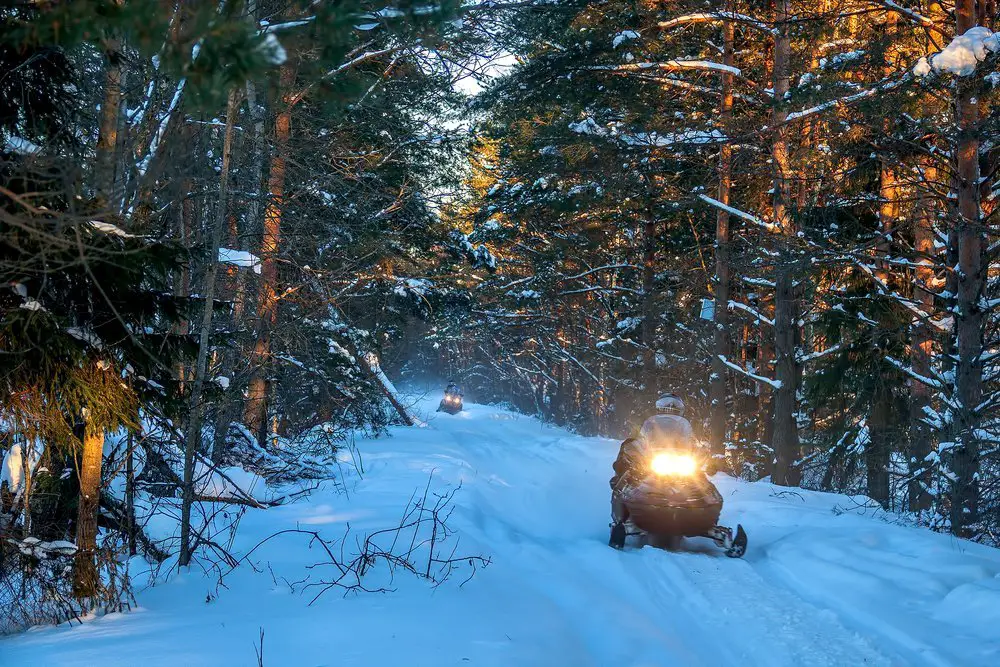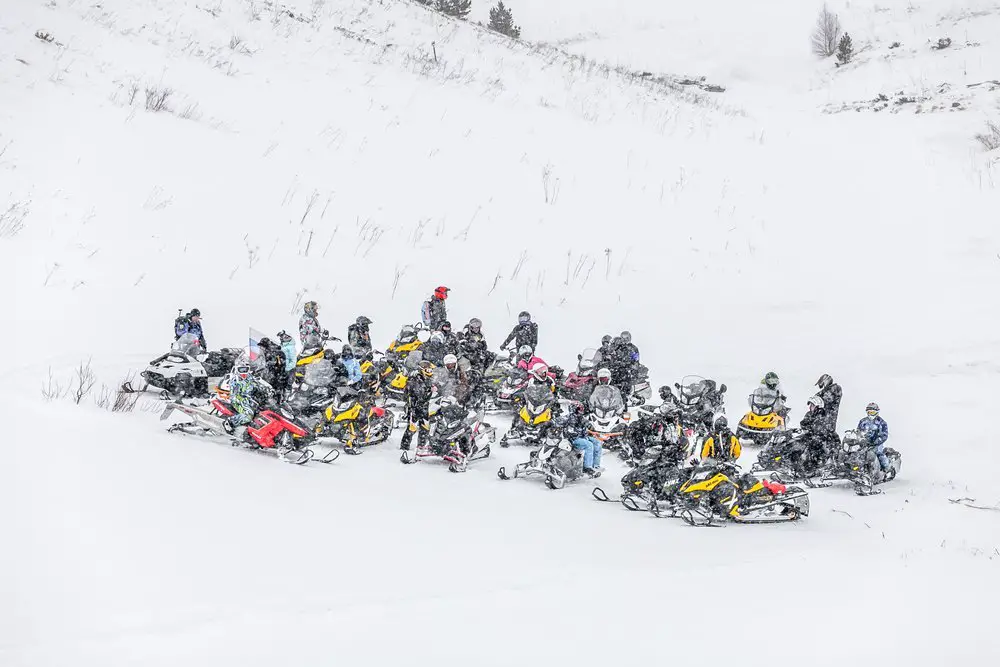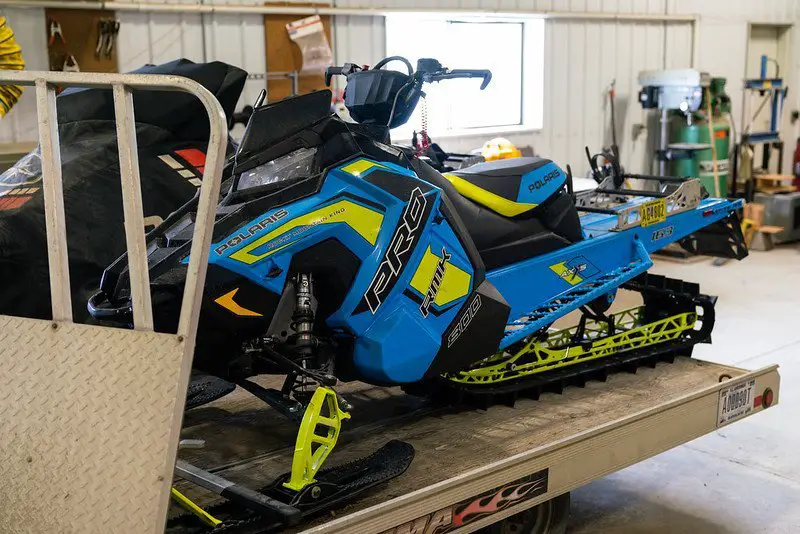What you wear snowmobiling is important, not only for your comfort, but also for your safety. The risk of hypothermia or frostbite while snowmobiling is not insignificant, and so dressing appropriately is important.
The first time I went snowmobiling I was wearing a cotton jacket, Jeans and some fairly thin gloves. Let’s just say it wasn’t the most comfortable experience.
First timers often ask the same first question, what clothing should I wear when I go snowmobiling? Here’s the answer.
The pieces of clothing you need to stay warm when snowmobiling are: A base layer (long johns), mid-layer (sweatshirt), Gore-Tex jacket and snow pants, warm gloves, smartwool socks, and winter boots. Gear to accompany your clothing should include a proper snowmobiling helmet and goggles.
But there is more to understand with this topic, please consider reading each section to understand why some snowmobiling clothing may be better than others in terms of safety, protection and warmth and why some materials should be avoided.
Table of Contents
What to wear snowmobiling and what to avoid
Before diving into each piece of clothing you will need, it’s important I tell you that you should avoid anything made of cotton entirely. Cotton kills, ever hear the saying? Cotton is super absorbent and when it gets wet, cotton can absorb 27 times its weight in water. This means your clothing will not only take longer to dry, but will also work to actively drop your body temperature, which could lead to hypothermia.
Clothing that doesn’t dry fast and holds water, mixed with travelling at a high speed through winter chilled air is a recipe for disaster.
With that out of the way, let’s look at some clothing that will keep you both warm, and safe on the trails.
Base layer
An base layer is a must, especially if you are going to be out in the cold for an extended period of time. Your base layer is the first piece of clothing you put on before you head out and is the layer that will be touching your skin.
Base layers are not vital for providing warmth, rather, it’s the quick wicking and drying properties that keep you dry, which make an under layer so important.
A Base layer made of polyester material is highly recommended for snowmobiling. Polyester is a moisture-wicking fabric that wicks away moisture from your skin. Keeping you dry and, therefore, warm.
Mid-layer
Your Mid-layer is the layer between your base layer and your jacket. You won’t always find that you need a mid-layer. Normally I reserve a mid-layer for when it gets really cold out.
Choosing your Mid-layer can be tricky. If you go too thick, you could find yourself becoming to warm as the day goes on. If you go too thin, you won’t be able to get warm. Things like how fast you plan on riding and what type of riding you do can play into this decision.
That said, fleece is a solid option for your mid-layer, as it provides moisture wicking properties and ample warmth.
Jacket
A good snowmobile jacket is key to staying warm. Your jacket should protect you from wind chill and allow snow to melt right off it, rather than soaking into the fabric making it heavy and drenched.
Gore-Tex Jackets are the norm in the snowmobile world. This is because Gore-Tex is a material that is not only waterproof, but breathable as well.
As I talked about earlier, you should avoid jackets that are made from cotton at all costs. Cotton is a summer material that is USELESS in the winter.
My first time snowmobiling I wore a cotton jacket, it was snowing pretty heavy that day and by the time we got about an hour into the trail I was soaking wet and freezing cold. My dad had us turn around and head back to the house to warm up, needless to say he wasn’t too impressed with me as he had warned me about this beforehand.
Snowmobile bibs
Your snowmobile bib will have the most contact with snow, other than your boots. So, like we talked about with Jackets, it’s best to get a pair of Gore-Tex snow pants that will keep you dry.
When it comes to bibs you can’t go wrong with Klim who are one of the most popular brands in the snowmobiling community, for good reason. Their snowmobile bibs are well insulated and come with gore-text protection that snow and water slide right off of.
Klim’s quality is second to none, and I especially love that they offer so many sizing options in some lines, including “short” bibs for us shorter folks.

And no, I’m not sponsored by Klim nor will I make any money if you purchase from them. I just love their product.
Gloves
Nothing sucks more than cold fingers.
Proper snowmobile gloves that will keep your hands warm and dry are an essential piece of snowmobiling clothing. When trying on a new pair of gloves, it’s important to see if you maintain enough mobile dexterity in your fingers to control the snowmobile.
On top of gloves, if you don’t have some already, you can look into getting hand guards for your snowmobile. These will help protect your hands from the wind chill, allowing you to go with a lighter, thinner pair of gloves that offer you more dexterity.
Socks
It doesn’t much matter what kind of socks you wear snowmobiling. Generally, socks you wear in your winter boots during the winter will be more than fine for snowmobiling.
However, the day I discovered smartwool socks for riding was probably the best day of my life. Smartwool socks work to wick moisture away from your feet, which is a life safer if you have perpetually sweaty feet as I do.
Balaclava
A balaclava is essentially a thin ski mask that you wear under your helmet to give your head some extra warmth.
They are amazing to have on freezing cold days and are rather inexpensive, so I’d recommended picking one up for the extra comfort its warmth provides.
Boots
Having warm feet is key to having a good time on the trails. Most companies offer specialized snowmobile boots that will provide you with good warmth, traction and keep your feet dry.
However, snowmobile boots can be expensive. So, if you have a good pair of winter boots that you’ve already worn for long durations in the cold and have kept your feet warm, they will be more than fine for snowmobiling.
Final thoughts
Staying warm is super important when you hit the snowmobile trails. Hypothermia and frostbite are nothing to mess around with.
Don’t be that person who wears shorts in the winter and says they aren’t cold. Dress for the weather, and always be sure to layer up.



